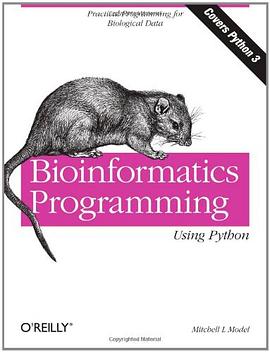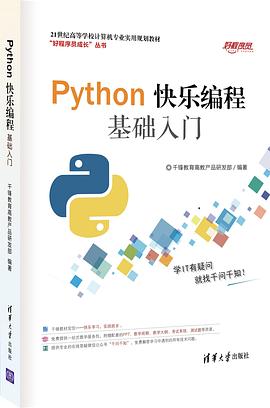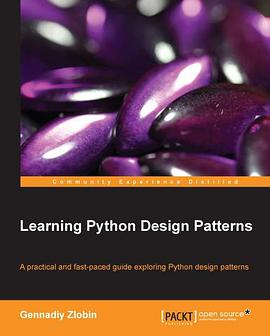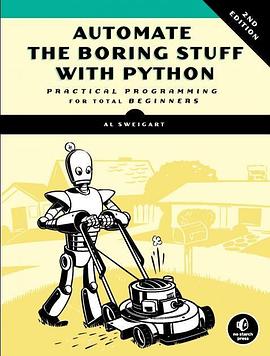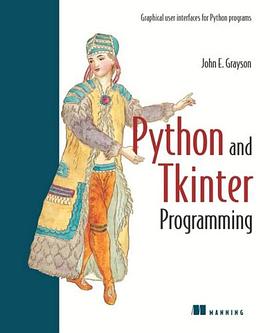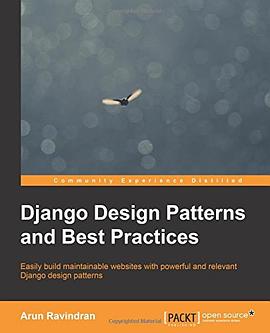

具体描述
In Starting Out with Python ® , Second Edition Tony Gaddis’ evenly-paced, accessible coverage introduces students to the basics of programming and prepares them to transition into more complicated languages. Python, an easy-to-learn and increasingly popular object-oriented language, allows readers to become comfortable with the fundamentals of programming without the troublesome syntax that can be challenging for novices. With the knowledge acquired using Python, students gain confidence in their skills and learn to recognize the logic behind developing high-quality programs.
Starting Out with Python discusses control structures, functions, arrays, and pointers before objects and classes. As with all Gaddis texts, clear and easy-to-read code listings, concise and practical real-world examples, detail-oriented explanations, and an abundance of exercises appear in every chapter. This text is intended for a one-semester introductory programming course for students with limited programming experience.
作者简介
目录信息
Chapter 1 Introduction to Computers and Programming 1
1.1 Introduction 1
1.2 Hardware and Software 2
1.3 How Computers Store Data 8
1.4 How a Program Works 13
1.5 Using Python 20
Chapter 2 Input, Processing, and Output 31
2.1 Designing a Program 31
2.2 Input, Processing, and Output 35
2.3 Displaying Output with the print Function 36
2.4 Comments 39
2.5 Variables 40
2.6 Reading Input from the Keyboard 49
2.7 Performing Calculations 53
2.8 More About Data Output 65
Chapter 3 Simple Functions 81
3.1 Introduction to Functions 81
3.2 Defining and Calling a Function 83
3.3 Designing a Program to Use Functions 89
3.4 Local Variables 95
3.5 Passing Arguments to Functions 97
3.6 Global Variables and Global Constants 107
Chapter 4 Decision Structures and Boolean Logic 117
4.1 The if Statement 117
4.2 The if-else Statement 125
4.3 Comparing Strings 130
4.4 Nested Decision Structures and the if-elif-else Statement 134
4.5 Logical Operators 142
4.6 Boolean Variables 149
Chapter 5 Repetition Structures 157
5.1 Introduction to Repetition Structures 157
5.2 The while Loop: a Condition-Controlled Loop 158
5.3 The for Loop: a Count-Controlled Loop 167
5.4 Calculating a Running Total 179
5.5 Sentinels 182
5.6 Input Validation Loops 185
5.7 Nested Loops 190
Chapter 6 Value-Returning Functions and Modules 203
6.1 Introduction to Value-Returning Functions: Generating Random Numbers 203
6.2 Writing Your Own Value-Returning Functions 214
6.3 The math Module 225
6.4 Storing Functions in Modules 228
Chapter 7 Files and Exceptions 239
7.1 Introduction to File Input and Output 239
7.2 Using Loops to Process Files 256
7.3 Processing Records 263
7.4 Exceptions 276
Chapter 8 Lists and Tuples 295
8.1 Sequences 295
8.2 Introduction to Lists 295
8.3 List Slicing 303
8.4 Finding Items in Lists with the in Operator 306
8.5 List Methods and Useful Built-in Functions 307
8.6 Copying Lists 314
8.7 Processing Lists 316
8.8 Two-Dimensional Lists 328
8.9 Tuples 332
Chapter 9 More About Strings 341
9.1 Basic String Operations 341
9.2 String Slicing 349
9.3 Testing, Searching, and Manipulating Strings 353
Chapter 10 Dictionaries and Sets 371
10.1 Dictionaries 371
10.2 Sets 394
10.3 Serializing Objects 406
Chapter 11 Classes and Object-Oriented Programming 421
11.1 Procedural and Object-Oriented Programming 421
11.2 Classes 425
11.3 Working with Instances 442
11.4 Techniques for Designing Classes 464
Chapter 12 Inheritance 483
12.1 Introduction to Inheritance 483
12.2 Polymorphism 498
Chapter 13 Recursion 509
13.1 Introduction to Recursion 509
13.2 Problem Solving with Recursion 512
13.3 Examples of Recursive Algorithms 516
Chapter 14 GUI Programming 529
14.1 Graphical User Interfaces 529
14.2 Using the tkinter Module 531
14.3 Display Text with Label Widgets 534
14.4 Organizing Widgets with Frames 537
14.5 Button Widgets and Info Dialog Boxes 540
14.6 Getting Input with the Entry Widget 543
14.7 Using Labels as Output Fields 546
14.8 Radio Buttons and Check Buttons 554
Appendix A Installing Python 567
Appendix B Introduction to IDLE 569
Appendix C The ASCII Character Set 577
Appendix D Answers to Checkpoints 579
Index 595
· · · · · · (收起)
读后感
评分
评分
评分
评分
用户评价
tp312py G123 入门书
评分It is a good book for selfstudy Python.
评分tp312py G123 入门书
评分看的是英文第四版;适合零基础入门,比较系统全面讲解了python的语法和数据结构和oop以及GUI,每章配有大量例子和习题,不过有点零碎,大概翻看了下;这本书有几个亮点吧,第一,第一章介绍计算机基础知识;前面几章最后面讲解了turtle 模块的使用,很有意思,能很好激发初学者的编程兴趣;最后一章,讲了一点GUI基础;以上。
评分看的是英文第四版;适合零基础入门,比较系统全面讲解了python的语法和数据结构和oop以及GUI,每章配有大量例子和习题,不过有点零碎,大概翻看了下;这本书有几个亮点吧,第一,第一章介绍计算机基础知识;前面几章最后面讲解了turtle 模块的使用,很有意思,能很好激发初学者的编程兴趣;最后一章,讲了一点GUI基础;以上。
相关图书
本站所有内容均为互联网搜索引擎提供的公开搜索信息,本站不存储任何数据与内容,任何内容与数据均与本站无关,如有需要请联系相关搜索引擎包括但不限于百度,google,bing,sogou 等
© 2025 book.quotespace.org All Rights Reserved. 小美书屋 版权所有

